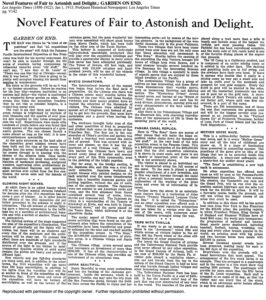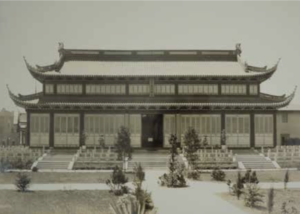 Newspaper Article: Novel Features of Fair to Astonish and Delight ((‘Novel Features of Fair to Astonish and Delight’, Los Angeles Times, January 1915.))
Newspaper Article: Novel Features of Fair to Astonish and Delight ((‘Novel Features of Fair to Astonish and Delight’, Los Angeles Times, January 1915.))
The Panama-Pacific International Exposition (PPIE) of 1915 held in San Francisco showcased diverse national exhibitions, attracting participation from numerous countries, including China and Japan. A 1915 newspaper article, titled Novel Features of Fair to Astonish and Delight published in the Los Angeles Times, highlighted the magnitude of the Chinese representation, describing ‘The Chinese Village’ spread across several acres with an investment exceeding $250,000.1 Also, the article provided insights into the Japanese exhibition, positioning China and Japan within the same narrative. Yet, despite being neighbouring nations in East Asia, the coverage indicates a differential emphasis, implying that Japan’s cultural and traditional elements garnered more attention and exploration compared to China. This observation underscores a Western inclination towards Japanese culture, reflecting broader global dynamics and preferences during the exposition.
When contrasting the introductions to the exhibition halls of China and Japan, the author’s focus on distinct details underscores a clear Western preference. In discussing the Chinese exhibition, emphasis was placed on the logistical aspects and physical layout rather than the thematic content. For instance, the author highlighted practicalities such as the requirement for Chinese visitors and workers to obtain permission and be accompanied by a guard when leaving the enclosure, as well as the presence of a four-foot wall surrounding the grounds and brightly adorned pagodas.2 A comprehensive overview of the exhibition’s contents was absent, with attention directed towards peripheral details. In contrast, the discussion of the Japanese exhibition was characterized by clarity and richness. The author delineated various ‘villages’ within the Japanese display, such as The Australasian Village and the Tehauntepec Village2 , before delving into intricate descriptions of its elements. Captivating features like a colossal Buddha at the entrance, the majestic backdrop of Fujiyama, a sand diviner, dromedaries, and even dancing girls adorning the exhibition streets2 were mentioned. The author concluded by asserting that the Japanese exhibition faithfully reproduced ‘the appearance of life in these interesting parts of the world.’2 Evidently, the introduction of the Japanese exhibition surpassed its Chinese counterpart in detail, cultural richness, and specificity of layout, underscoring a notable discrepancy in Western portrayal.
However, was the Chinese exhibition perceived as dull at this exposition? Did it fail to adequately showcase elements of its own culture? In fact, William Peterson’s chapter on this subject reveals a different narrative. Peterson illustrates that the planners made concerted efforts to showcase Chinese cultural elements, exemplified by the meticulous replication of the ‘Forbidden City’ (Figure 1.). The replicated imperial architecture could demystify the enigmatic realm and signal China’s openness to global engagement.3 Besides, the Chinese exhibition contained a small section titled ‘Underground Chinatown’ featured mannequins engaging in activities such as gambling and opium consumption,4 which caused an immediate response in the local Chinese-language press.5 Despite the detailed efforts to infuse cultural elements at the PPIE, these nuances were absent in the newspaper. While the author mentioned features like replicated city walls built by Chinese workers, the author failed to explore the deeper cultural significance behind these structures, underscoring a broader media ignorance regarding Chinese cultural representation at the exposition.
 Figure 1. The replica of Beijing’s ‘Forbidden City’.6
Figure 1. The replica of Beijing’s ‘Forbidden City’.6
Additionally, while introducing the Chinese exhibition, the author interjected Japanese elements into the Chinese section. Following the mention of Chinese walls, the author swiftly transitioned to describe the nearby Japanese site as a beautiful Japanese garden. In stark contrast to the supposed plain ground of the Chinese exhibition (which was inaccurately depicted), the Japanese site boasted numerous ancient temples, including a replicated Japanese temple of Kinkakuji at Kioto, along with Japanese rocks, trees, shrubs, and sod.1 These details, however, were presented within the context of the ‘Mystic Chinatown’ section.
As the author noted, there was a rivalry for early attention between the Chinese and Japanese exhibitions.2 However, judging by the level of detail provided, it is apparent that the Japanese exhibition garnered more attention within the exposition. In this rivalry, it seemed the Japanese exhibition emerged as the clear winner.
Bibliography
Primary Source
“Novel Features of Fair to Astonish and Delight.” Los Angeles Times. January 1915.
Secondary Source
Peterson, William. Asian self-representation at world’s fairs. Amsterdam: Amsterdam University Press, 2020.